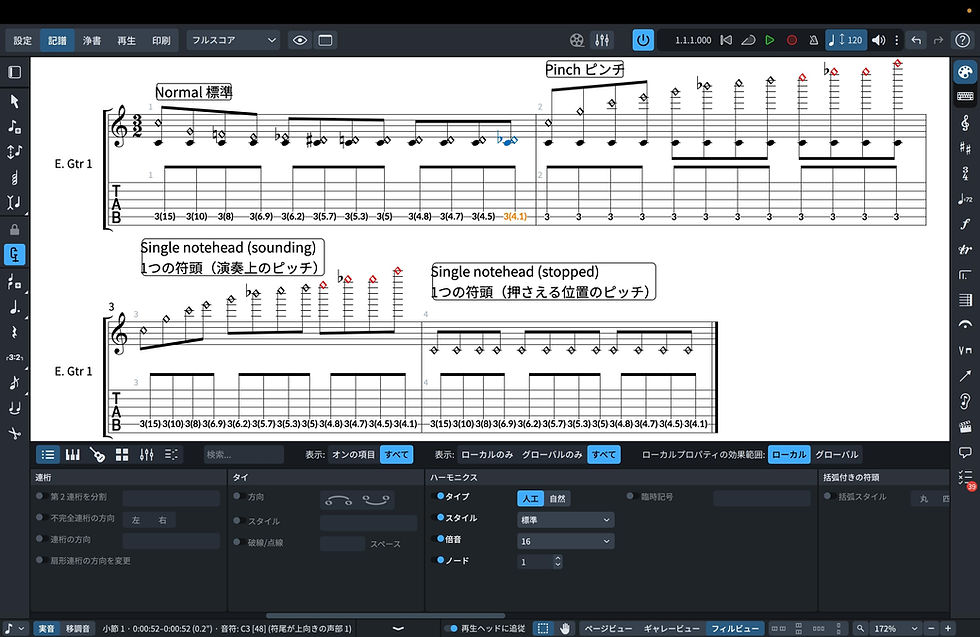Expressing Guitar Harmonics in Dorico
- tarokoike

- Aug 17
- 4 min read
Updated: Aug 18
Back in March 2024, I wrote an article titled “Comparison of guitar harmonics expressions in music notation software”, but at the time, I focused on Finale and didn't talk much about Dorico. So this time, I'd like to focus on Dorico Pro 6 and delve deeper into its features.
When it comes to guitar notation, Finale showed outstanding strengths in writing standard notation (※1), as the global standard tool for music publishing. However I have to say, its tablature function was surprisingly minimal. (※2)
※1: Hereinafter, this will be referred to as a “notation staff” to distinguish it from tablature.
※2: For example, the content of standard staves and tablature was not automatically linked (though it was good at writing Japanese-style tablature because of that), enclosures for half and whole notes had to be manually created and pasted, and decimal points could not be used for harmonics nodes. This may have been because Finale's primary target market might not be musical genres that use tablature.
When it comes to guitar tablature, Guitar Pro has traditionally been the dominant player, but Dorico's tablature functionality, while still in its developmental stages, is quite impressive. It may already surpass Guitar Pro in its handling of harmonics, in particular.
[Table of Contents]
---
1. Expressing Various Harmonic Playing Techniques
In the March 2024 article, we looked at the Dorico series’ mid-range product Dorico Elements and a free product Dorico SE. Now let's take a look at the same example music created in Dorico Pro 6.
Here's an example created in Dorico Elements.

Here's an example created in Dorico Pro. It features an Engraving Options dialog box not found in Elements, which allows you to set stem attachment positions and add enclosures to tablature numbers for half and whole notes.

(Back to Table of Contents)
2. Natural Harmonics
In Dorico, when you enter natural harmonics on a notation staff, the position of the node is automatically displayed on the tablature. For nodes that are not exactly above a fret, the precise position is displayed as a decimal point, which is a major difference from Finale where you could only enter integers as tablature numbers.
This example shows natural harmonics for guitar and bass in normal tuning, arranged from low to high.
Natural harmonics below the second fret are generally not very practical, but Dorico can automatically notate natural harmonics up to the 1.1 fret position.

Natural harmonics above the third harmonic have multiple nodes, and Dorico can handle nodes up to the 16th order.
The following example shows a list of nodes on the E and A strings for a natural harmonic with multiple nodes. Experienced guitarists may have mastered the subtle positions of these nodes through experience, but quantifying them like this makes them easy for even beginners to perform.
Guitar Pro 8 can also automatically display natural nodes like this, but only up to the practical eighth harmonic. While the 11th harmonic Dorico can display is theoretical, it could potentially be used in physics classes rather than guitar lessons.

(Back to Table of Contents)
3. Artificial Harmonics
Dorico allows you to express artificial harmonics on guitar in two ways: touch harmonics (※1) and pinch harmonics (※2).
※1: This is a playing technique in which the index finger on the plucked side touches the node and the ring finger or little finger plucks the string. However, on distorted guitars, it can also be played as tapping harmonics.
※2: In Japan, this playing technique is called “picking harmonics”, but the term “pinch harmonics” seems to be more commonly used in English-speaking countries, and Dorico uses this term as well.

Touch harmonics, following traditional notation methods like those used for violins, use diamond noteheads to indicate the node location where the finger's pinky finger touches the string, resulting in a somewhat strange phenomenon: as the played pitch rises, the notated pitch drops.
With this notation, if the interval between the pressed and touched notes is a second, it's impossible to distinguish between them on the staff. In that case, you can either add the pressed note to a “Single Notehead” notation in a separate voice, or use pinch harmonics.
ーーー
Since it was impossible for Finale to accurately express harmonic nodes using decimal fractions, many publications were showing higher-order harmonic nodes in guitar scores, for example, by indicating the fret number “4” on tablature, with a description such as “slightly closer to the 3rd fret than exactly above the 4th fret”.
There are many cases where the specifications of a production tool (software inparticular) influences on your creativity, and this may be one example where Finale's technical limitations have had a negative impact on the final product.
The music publishing industry is being forced to switch from Finale to Dorico as the standard tool due to the software industry's circumstances, but I hope that Dorico's use of decimal notations to represent harmonic nodes will make pubished guitar notation easier to understand than before.
(Back to Table of Contents)

